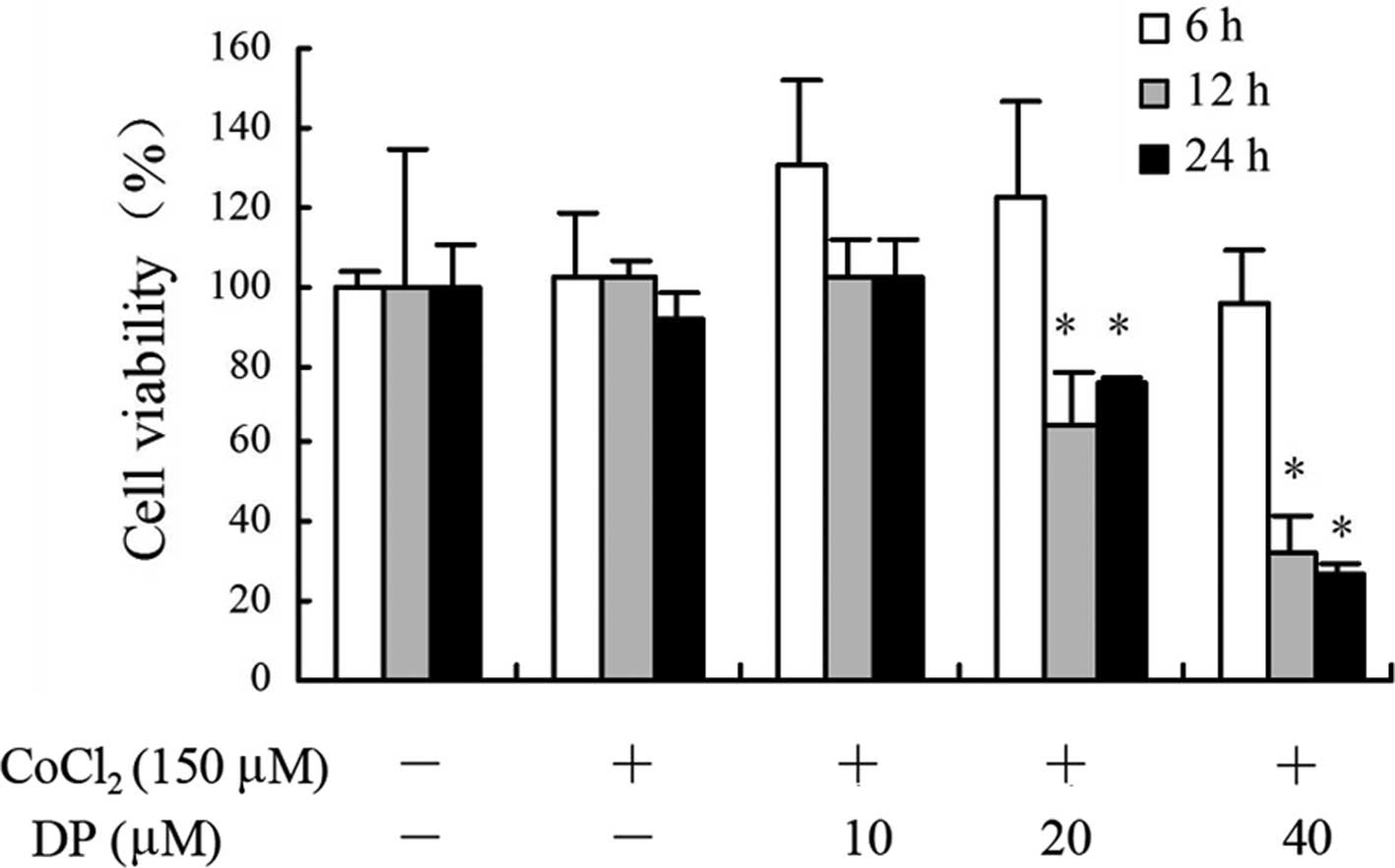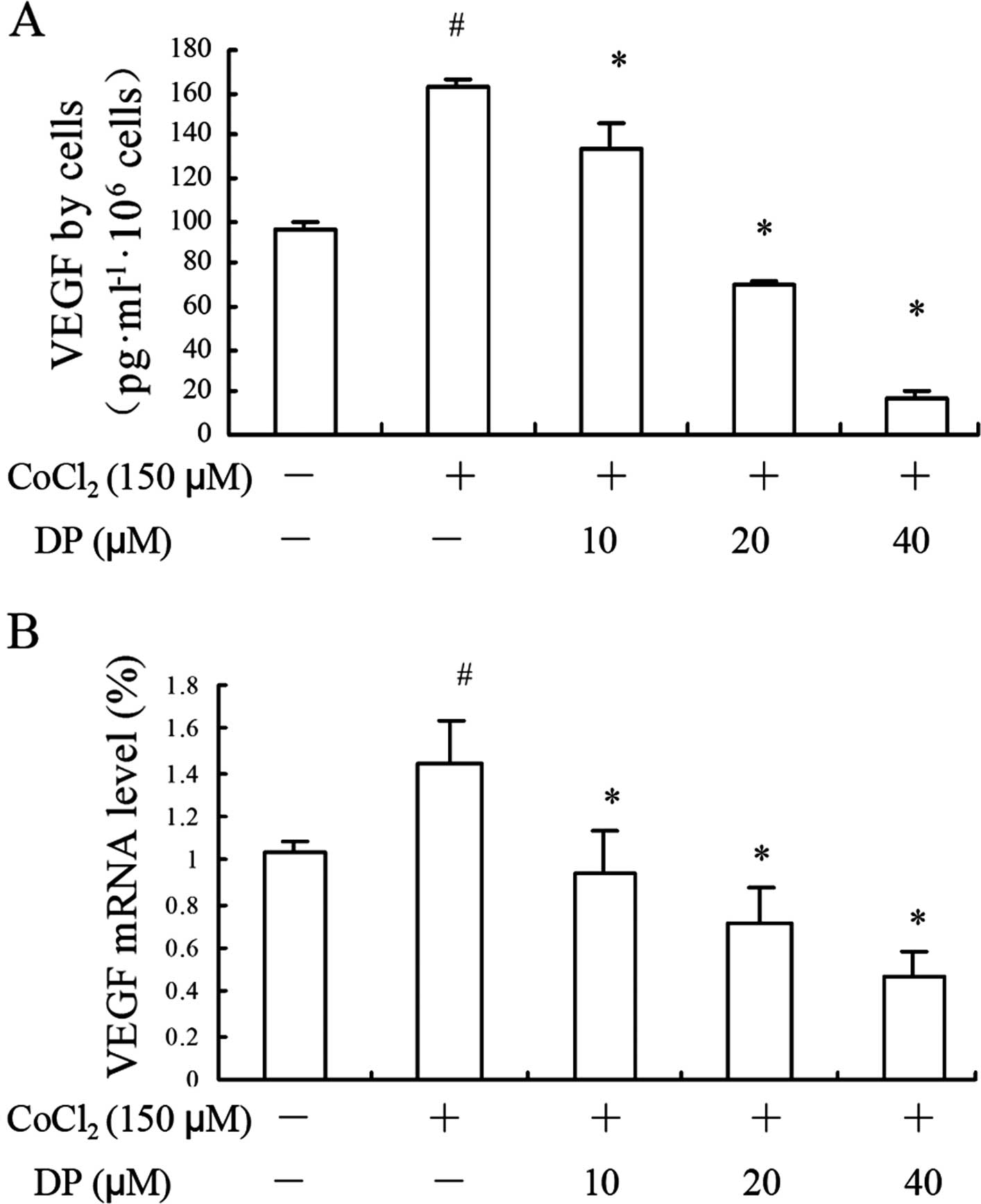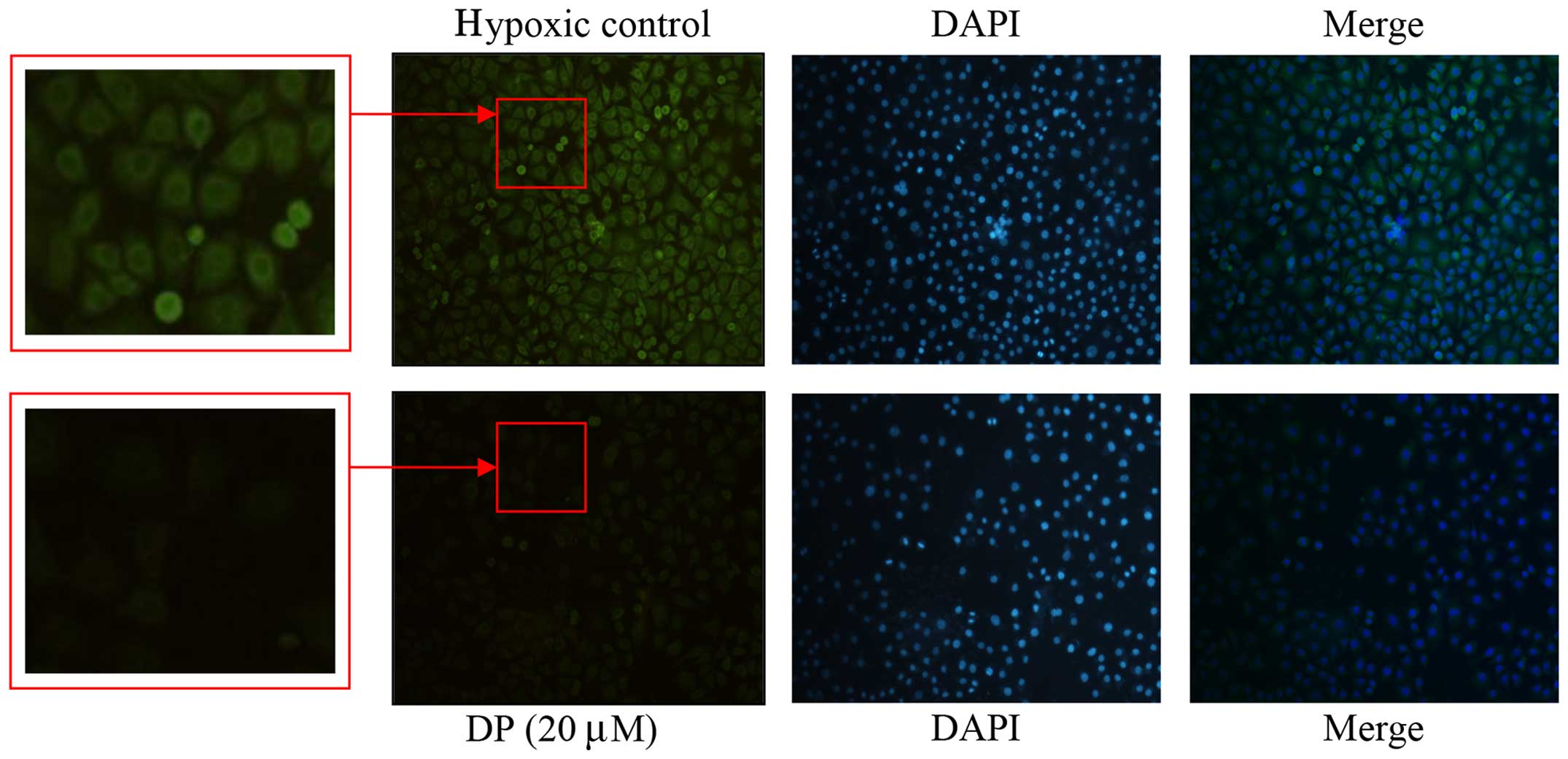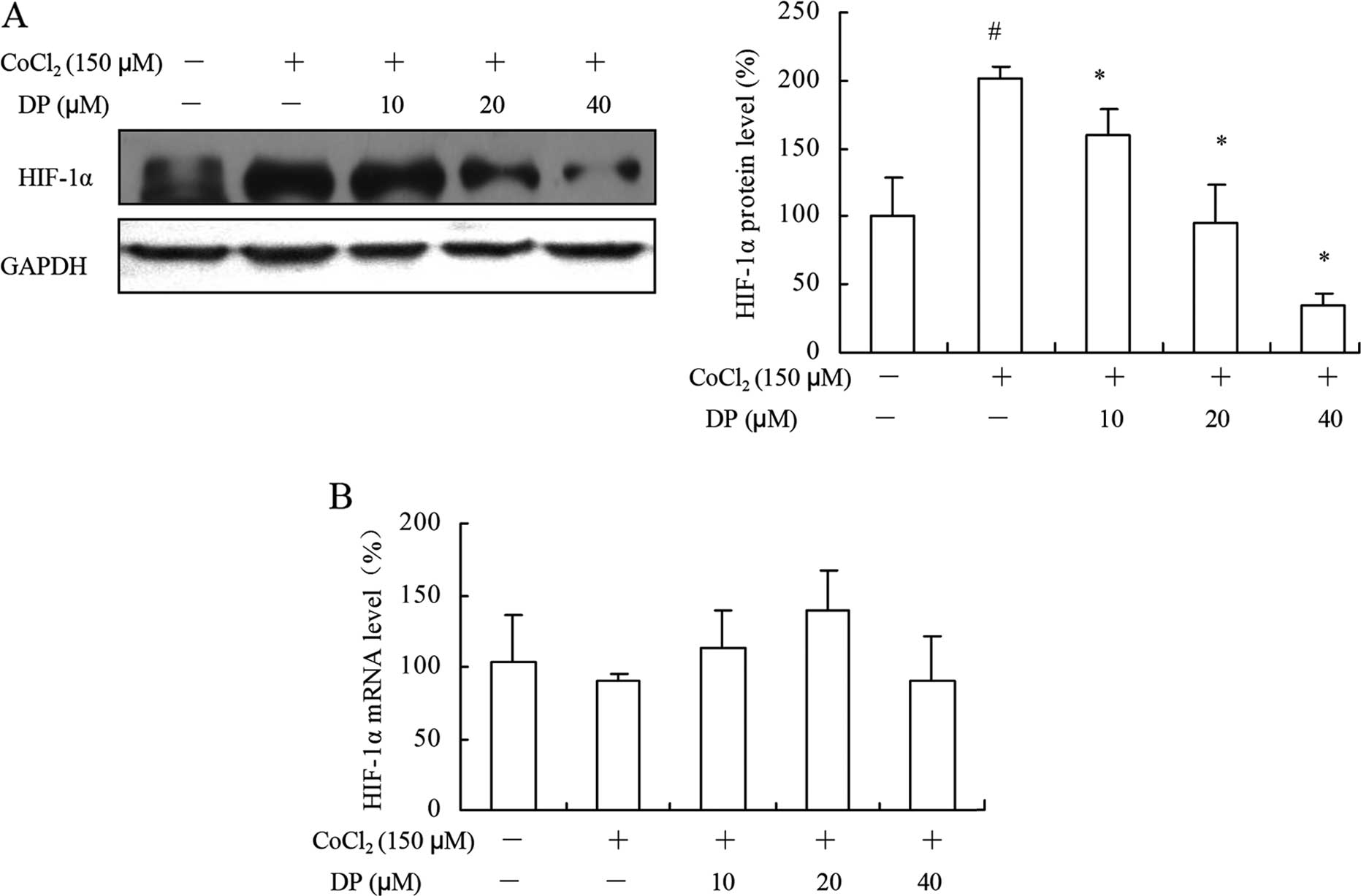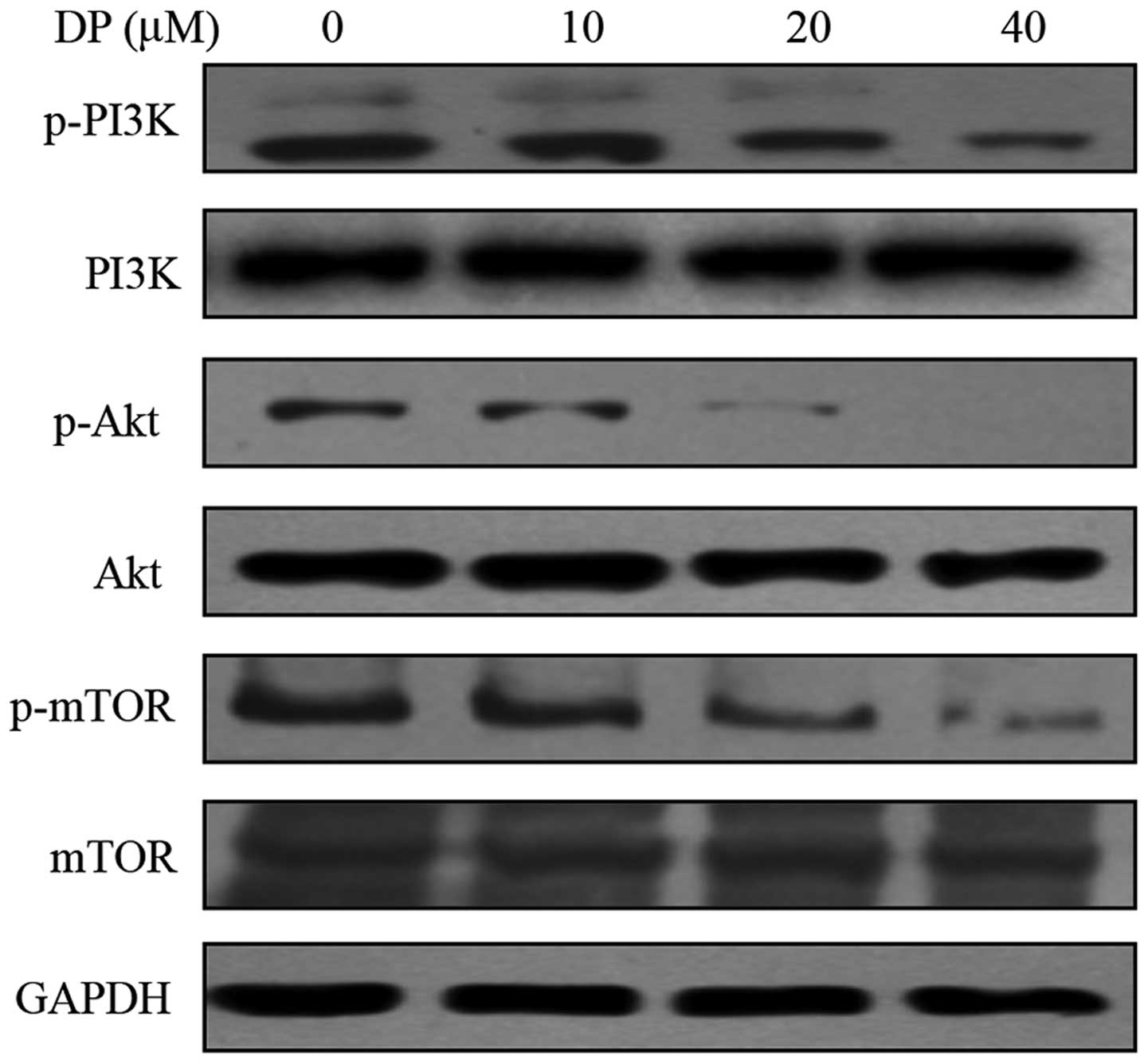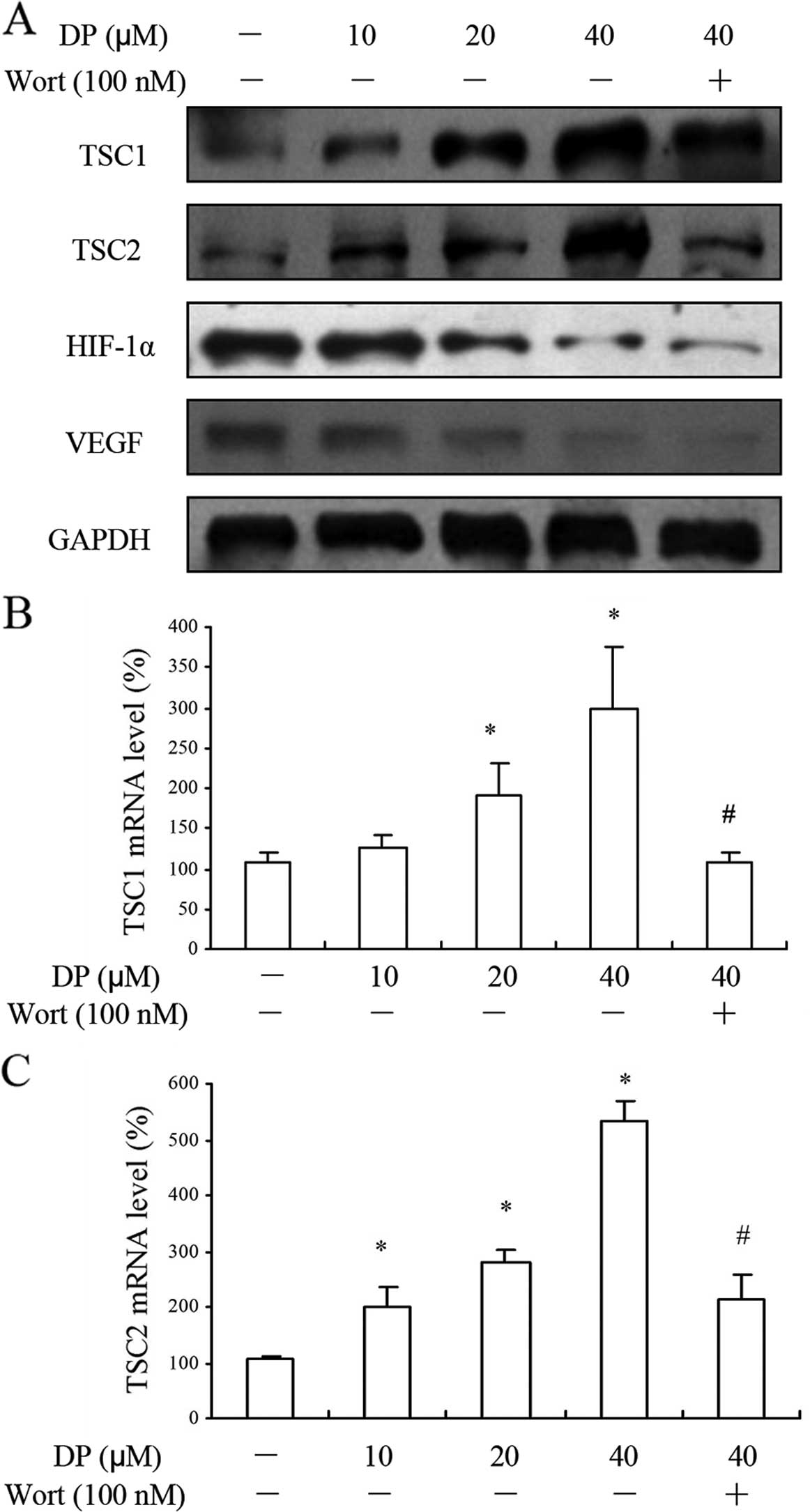12-Deoxyphorbol 13-palmitate inhibits the expression of VEGF and HIF-1α in MCF-7 cells by blocking the PI3K/Akt/mTOR signaling pathway
- Authors:
- Published online on: July 31, 2015 https://doi.org/10.3892/or.2015.4166
- Pages: 1755-1760
Abstract
Introduction
Breast cancer is a heterogeneous disease with various subtypes exhibiting distinct biological features, resulting in differences in response patterns to various clinical strategies and treatment modalities (1). Currently, the research of breast cancer in regards to molecular techniques and gene signatures has been a central issue for the development of novel therapeutics (2). Angiogenesis, one of the established approaches for targeting tumors, is a complex procedure containing a succession of genetic alterations, of which VEGF is a key mediator. In accordance with the results of various preclinical studies, significant therapeutic effects of VEGF blockers have been demonstrated in various types of cancers, even in some progressive cancers (3). Our previous study on 12-deoxyphorbol 13-palmitate (DP) showed that it possesses an anti-angiogenesis effect in vitro and in vivo through the VEGFR-2-signaling pathway (4). In the present study, we explored the ability of DP to inhibit the expression of VEGF and hypoxia inducible factor-1α (HIF-1α) via the PI3K/Akt/mTOR pathway.
VEGF is an endothelial cell-specific mitogen and VEGF-mediated related signaling contributes to key aspects of tumor angiogenesis and vascular permeability (5). The upstream gene of VEGF, HIF-1α, is overexpressed in the early stages of mammary carcinogenesis, and is correlated with diagnostic and prognostic indicators, making HIF-1α a potential target for new approaches to inhibit angiogenesis (6). HIF-1α, under hypoxic stress, binds with HIF-1β, and controls the expression of multiple downstream target genes by combining with hypoxia response elements (HREs) of the target genes inside the nucleus to promote further responses (7). The expression of HIF-1α is controlled by multiple mechanisms, in which protein ubiquitination is primarily involved. In addition, research has found that HIF-1α accumulation depends on de novo protein synthesis (9), and some pathways participate in the regulation of HIF-1α, such as the PI3K/Akt/mTOR pathway (10).
PI3K/Akt/mTOR, a crucial intracellular pathway, has been well established to play a significant role in tumor cell proliferation and growth (11). Activation of PI3K transforms phosphatidylinositol 4,5-bisphosphate (PIP2) to phosphatidylinositol 3,4,5-triphosphate (PIP3), and then triggers Akt phosphorylation on Thr 308. Phosphorylated Akt unleashes mTOR through inactivation of TSC1/TSC2 (12). mTOR, a protein kinase, is a therapeutic target for cancer treatment which is ubiquitously expressed in cells (13). As a tumor-suppressor, the TSC-TSC2 complex emerges as a critical negative regulator of signaling downstream of Akt and upstream of mTOR (14). Accumulated evidence from cancer and genetic biology indicates the benefit of targeting the PI3K/Akt/mTOR signaling pathway to inhibit tumor angiogenesis. Collectively, we hypothesized that DP possesses anticancer activity in breast cancer by impacting tumor angiogenesis.
Materials and methods
Materials
DP was isolated from Euphorbia fischeriana and its purity was >99% as characterized by gas chromatography. The Valukine Human VEGF Immunoassay kit was purchased from R&D Systems (Minneapolis, MN, USA). Wortmanin was purchased from Cayman (Denver, CO, USA). Cell culture reagents were purchased from HyClone (Logan, UT, USA). MTT, dimethylsulfoxide (DMSO) and CoCl2 were purchased from Sigma-Aldrich (St. Louis, MO, USA). RNAiso Plus, SYBR® Premix Ex Taq™ and PrimeScript® RT reagent kit (Perfect Real Time) were purchased from Takara (Dalian, Liaoning, China).
Cell culture
The human breast cancer cell line MCF-7 was purchased from the American Type Culture Collection (ATCC) (Rockville, MD, USA), and cultured in Dulbecco's modified Eagle's medium (DMEM) supplemented with 10% fetal bovine serum (FBS), 100 U/ml penicillin and 100 μg/ml streptomycin. The cells were maintained at 37°C in a CO2 incubator with an atmosphere composed of 5% CO2 and 95% air. To mimic a hypoxic condition, the cells were treated with 150 μM CoCl2 as the hypoxic control group.
Cell viability assay
The cells were divided into normoxic and hypoxic control groups and treated with various concentrations (10–40 μM) of DP. Cell viability was determined by the MTT assay. MCF-7 cells were seeded in 96-well plates at a density of 3×103 cells/well and incubated for 6, 12 and 24 h after a 12-h adherence. Then, 20 μl of MTT solution (5 mg/ml) was added into each well for another 4-h incubation at 37°C. After 4 h, the medium was removed and the crystals were dissolved using 200 μl DMSO before constant shaking for 10 min. The absorbance values were analyzed by an enzyme-labeling instrument at 570 nm. Three replicate were conducted for the MTT assay.
Enzyme-linked immunosorbent assay (ELISA) for VEGF
For quantification of VEGF excreted by the MCF-7 cells, the cells were incubated overnight in 6-well dishes with 2×106 cells/well. Following DP treatments for 12 h, the medium was collected and examined by a Valukine Human VEGF Immunoassay kit following the manufacturer's instructions.
RT-qPCR
After DP treatments, total RNA was isolated from the cells using total RNA extraction reagent RNAiso Plus according to the product manual. Total RNA was reverse-transcribed to cDNA with the PrimeScript® RT reagent kit following the manufacturer's instructions. The amplification of cDNA was performed in triplicate using SYBR® Premix Ex Taq™ kit under conditions of 95°C for 30 sec, 95°C for 5 sec and 60°C for 31 sec. The VEGF, HIF-1α, TSC1 and TSC2 mRNA were analyzed and the final data were presented using the 2−ΔΔCt method. The primer sequences used for real-time PCR were: VEGF F, 5′-GTCCAACTTCTGGGCTGTTCT-3′ and R, 5′-CCCTCTCCTCTTCCTTCTCTTC-3′; HIF-1α F, 5′-TAGCCGAGGAAGAACTATGAAC3′ and R, 5′-CACACT GAGGTTGGTTACTGTTG3′; TSC1 F, 5′-GCACTCTTT CATCGCCTTTATG-3′ and R, 5′-ATCATTGGCTTGAC CACTTCTT-3′; TSC2 F, 5′-CAGACAATGGGAGACACAT CAC-3′ and R, 5′-CtAAGTTCACCAGCACCAGAAG-3′.
Western blotting
MCF-7 cells were incubated overnight before treatment with various concentrations of DP and wortmannin for 12 h. After washing with cold PBS twice, the cells were lysed with RIPA lysis buffer (Beyotime, Shanghai, China), and total proteins were quantitated with a BCA protein assay kit (CWBio, Beijing, China). Equal protein (30 μg) of each sample was separated by SDS-polyacrylamide gels (SDS-PAGE) and then blotted onto polyvinylidene fluoride (PVDF) membranes. The membranes were incubated with the primary mouse antibodies against GAPDH (CWBio), HIF-1α (BD Biosciences, Minneapolis, MN, USA), TSC1 (Cell Signaling Technology, Danvers, MA, USA) and rabbit antibodies against VEGF (Abcam, Cambridge, UK), TSC2, p-Akt, Akt, p-PI3K, PI3K, mTOR and p-mTOR at 4°C overnight followed by HRP-conjugated anti-rabbit IgG or HRP-conjugated anti-mouse IgG antibody (both from Cell Signaling Technology) incubated for 2 h at room temperature. Blots were then visualized using the West Pico Chemiluminescent Substrate (Pierce, Woburn, MA, USA). GAPDH was used as the internal reference.
Immunofluorescence
MCF-7 cells were plated in 6-well plates, then treated with DP (0 and 20 μM) for 12 h. After incubation overnight at 4°C with a 1:100 dilution of mouse anti-HIF-1α, the cells were washed three times with PBS and then incubated with an anti-mouse FITC-labeled secondary antibody for 1 h, and then cells were stained with DAPI for 5 min after washing three times. The immunofluorescence was observed with a confocal laser scanning microscope (Olympus, Tokyo, Japan).
Statistical analysis
All data are presented as the mean ± SD. Student's t-tests were conducted to analyze the differences between experimental groups and control groups using SPSS 13.0 (SPSS, Inc., Chicago, IL, USA). A P-value of ≤0.05 was considered to indicate a statistically significant result.
Results
DP inhibits the proliferation of MCF-7 cells
In this experiment, we tested the effect of DP on the proliferation of MCF-7 cells using MTT assay. Results of the MTT assays showed that following treatment with 150 μM CoCl2, the cell viability did not exhibit significant differences compared with the normoxic control (Fig. 1). DP decreased the viability of MCF-7 cells in a time- and dose-dependent manner. DP reduced the viability slightly at 6 h without any statistical differences following treatments at 10, 20 and 40 μM. Treatment at 10 μM showed no inhibition when compared with the hypoxic control at 6, 12 and 24 h. Treatments at 20 and 40 μM inhibited the cell viability which ranged between 26 and 75% at 12 and 24 h.
DP reduces the transcription and excretion of VEGF
VEGF is activated not only in normal human tissues yet is also associated with oncogenesis of breast cancer (15). As an important pro-angiogenic factor, VEGF excreted from tumor cells promotes the development of nearby vessels. In the present study, we investigated the impact of DP on VEGF protein and mRNA levels by ELISA and RT-qPCR assays, respectively. In the ELISA assay, the VEGF accumulation is presented as normalized data based on the cell number. A notable increase in VEGF level was detected when cells were exposed to a hypoxia condition, and DP downregulated VEGF at both the protein (Fig. 2A) and mRNA (Fig. 2B) levels. The results indicated that DP reversed the expression and transcription of VEGF induced by hypoxia, which confirms it to be a potential inhibitor for reducing neovascularity.
DP re-distributes the location of HIF-1α
An increase and stabilization of nuclear translocation of HIF-1α is a key factor to VEGF gene expression and angiogenesis (16). To explore the effect of DP on the location of HIF-1α, immunofluorescence was used. As shown in Fig. 3, in the presence of DP, the HIF-1α fluorescent intensity became weaker. Simultaneously, the localization of HIF-1α was re-distributed in the cells. The expression of HIF-1α was obviously concentrated in and around the nucleus in the hypoxic control, yet this accumulation decreased after the addition of DP (20 μM), which confirmed that DP interrupts nuclear HIF-1α translocation.
DP inhibits the expression of HIF-1α without affecting its transcriptional activity
Hypoxia is involved in the process of angiogenesis, and a growing number of studies have focused on regulating the HIF family to alter the expression of VEGF (17). To further confirm the results above, western blotting and RT-qPCR were performed to examine the total HIF-1α expression in the cells. As shown in Fig. 4A, MCF-7 cells were treated with different concentrations of DP under a hypoxia condition for 12 h. The protein level of HIF-1α under a hypoxia condition was markedly increased when compared with the level under a normoxic condition, and this increase was abolished by DP in a concentration-dependent manner. However, the protein level was downregulated while the mRNA level of HIF-1α remained unchanged (Fig. 4B), suggesting that DP may downregulate the expression of HIF-1α without affecting it at the transcriptional level in the MCF-7 cells.
DP inhibits the PI3K/Akt/HIF-1α signaling pathway in MCF-7 cells
The PI3K/Akt/HIF-1α pathway is important in the majority of human types of cancers. Research has found that the PI3K/Akt pathway is involved in tumor angiogenesis by an HIF-1-dependent mechanism (18). To evaluate the effect of DP on the PI3K/Akt/HIF-1α pathway, we detected the phosphorylation of PI3K, Akt and mTOR. The MCF-7 cells were treated with DP at various concentrations under a hypoxic condition for 12 h. Treatment of DP resulted in a decrease in the expression of p-PI3K, which was correlated with its effectors p-Akt and p-mTOR, whereas DP did not affect the total protein levels of these proteins (Fig. 5).
DP regulates HIF-1α and VEGF in a PI3K and TSC1/TSC2-dependent manner
TSC1 and TSC2 are tumor-suppressor genes, and important negative regulators of mTOR, with responsiveness to the growth factors related to PI3K and Akt (19). DP enhanced the protein levels of TSC1 and TSC2 in the MCF-7 cells in a concentration-dependent manner, and this enhancement by DP required the activity of PI3K, as the addition of the PI3K inhibitor wortmannin (100 nM) significantly reversed this effect. Next, we found that co-treatment of wortmannin with DP (40 μM) downregulated the expression of HIF-1α and VEGF slightly by western blotting (Fig. 6A). Furthermore, the RT-qPCR results exhibited the same tendency of TSC1 and TSC2 mRNA with the protein levels (Fig. 6B and C). These results collectively suggest that DP inhibited VEGF and HIF-1α through a PI3K-related signaling pathway.
Discussion
Breast cancer is the leading cause of cancer-related death in females. It is a heterogeneous disease and is commonly associated with epigenetic and multiple genetic abnormalities (20,21). Breast cancer is angiogenesis-dependent, which explains its vulnerability to various angiogenesis-related factors such as vascular endothelial growth factor (VEGF) in preclinical and clinical research (22). Reich et al found that the blockade of VEGF by small interfering RNA (siRNA) inhibited neovascularization in a mouse model (23). Considering the central importance of VEGF emphasized by clinical trials (24), bevacizumab, a humanized murine monoclonal antibody with strong affinity for VEGF, is the most popular anti-angiogenic agent used in cancer therapy (25). Therefore, in the present study, we found that 12-deoxyphorbol 13-palmitate (DP) suppressed the mRNA level and excretion of VEGF in MCF-7 cells. Thus, we speculated that DP influences the growth of blood vessel in breast tumors.
Hypoxia-inducible factor-1α (HIF-1α) is a strong stimulator of neovascularization and excretion of VEGF at the transcription level (26–29). We identified that DP has the potential to inhibit VEGF expression in MCF-7 cells. Thus, we next detected the effect of DP on HIF-1α. HIF-1α is sensitively regulated by hypoxia, and mediates the adaptation of cells to low oxygen states (30,31). Thus, in our experiment, CoCl2 was used to mimic hypoxia, at least in part (32). The hypoxia-induced increase in HIF-1α was blocked by the addition of DP at the protein level but not at the mRNA level, which is in accordance with previous studies (33,34), and which is presumably linked to increasing HIF-1α translation (35). Given the findings, it is concluded that DP suppressed HIF-1α-mediated VEGF expression.
The PI3K/Akt/mTOR signaling pathway plays a critical role in regulating cellular properties, such as proliferation, motility, survival and angiogenesis (36). The activation of the PI3K/Akt/mTOR pathway in tumor cells increases the excretion of VEGF by both HIF-1-dependent and -independent mechanisms, and the induction of HIF-1α inhibits mTOR activation and stimulates the VEGF-VEGFR1 angiogenic pathway, which is turned off as hypoxia subsides (37,38). In contrast, the inhibition of this pathway by LY294002 and mTOR inhibitor rapamycin was found to reduce the accumulation of HIF-1α in MCF-7 and prostate cancer cell lines (39). We identified that DP interrupted the PI3K/Akt/mTOR cascade. Moreover, it has been reported that phosphorylated Akt unleashes mTORC1 by inhibiting activation of TSC1 and TSC2 (40). Indeed, in the present study, the DP-induced increase in TSC1 and TSC2 was blocked by addition of wortmannin, which together suggest that DP downregulates VEGF and HIF-1α by interrupting the PI3K pathway.
Concerning clinical development, the complexity of the PI3K/Akt/mTOR pathway and its extensive crosstalk with other kinase cascades, will result in challenges in identifying patients who will benefit most from breast cancer treatments (41,42). DP may be a potential anti-VEGF and -HIF-1α drug for breast cancer. Yet, its potential side-effects require careful investigation.
Acknowledgments
We gratefully acknowledge the support from members of the Department of Medicinal Chemistry and Biomacromolecules. The present study was supported by the Natural Science Foundation of China (grant no. 81374021).
References
|
Yersal O and Barutca S: Biological subtypes of breast cancer: Prognostic and therapeutic implications. World J Clin Oncol. 5:412–424. 2014. View Article : Google Scholar : PubMed/NCBI | |
|
Tomao F, Papa A, Zaccarelli E, Rossi L, Caruso D, Minozzi M, Vici P, Frati L and Tomao S: Triple-negative breast cancer: New perspectives for targeted therapies. Onco Targets Ther. 8:177–193. 2015. View Article : Google Scholar : PubMed/NCBI | |
|
Kubota Y: Tumor angiogenesis and anti-angiogenic therapy. Keio J Med. 61:47–56. 2012. View Article : Google Scholar : PubMed/NCBI | |
|
Xu HY, Pan YM, Chen ZW, Lin Y, Wang LH, Chen YH, Jie TT, Lu YY and Liu JC: 12-Deoxyphorbol 13-palmitate inhibit VEGF-induced angiogenesis via suppression of VEGFR-2-signaling pathway. J Ethnopharmacol. 146:724–733. 2013. View Article : Google Scholar : PubMed/NCBI | |
|
Goel HL and Mercurio AM: VEGF targets the tumour cell. Nat Rev Cancer. 13:871–882. 2013. View Article : Google Scholar : PubMed/NCBI | |
|
Kimbro KS and Simons JW: Hypoxia-inducible factor-1 in human breast and prostate cancer. Endocr Relat Cancer. 13:739–749. 2006. View Article : Google Scholar : PubMed/NCBI | |
|
Zbytek B, Peacock DL, Seagroves TN and Slominski A: Putative role of HIF transcriptional activity in melanocytes and melanoma biology. Dermatoendocrinology. 5:239–251. 2013. View Article : Google Scholar | |
|
Li M and Kim WY: Two sides to every story: The HIF-dependent and HIF-independent functions of pVHL. J Cell Mol Med. 15:187–195. 2011. View Article : Google Scholar : | |
|
Thomas GV, Tran C, Mellinghoff IK, Welsbie DS, Chan E, Fueger B, Czernin J and Sawyers CL: Hypoxia-inducible factor determines sensitivity to inhibitors of mTOR in kidney cancer. Nat Med. 12:122–127. 2006. View Article : Google Scholar | |
|
Liu L, Ning X, Han S, Zhang H, Sun L, Shi Y, Sun S, Guo C, Yin F, Qiao T, et al: Hypoxia induced HIF-1 accumulation and VEGF expression in gastric epithelial mucosa cell: Involvement of ERK1/2 and PI3K/Akt. Mol Biol. 42:459–469. 2008.In Russian. View Article : Google Scholar | |
|
Paplomata E and O'Regan R: The PI3K/AKT/mTOR pathway in breast cancer: Targets, trials and biomarkers. Ther Adv Med Oncol. 6:154–166. 2014. View Article : Google Scholar : PubMed/NCBI | |
|
Gomez-Pinillos A and Ferrari AC: mTOR signaling pathway and mTOR inhibitors in cancer therapy. Hematol Oncol Clin North Am. 26:483–505. vii2012. View Article : Google Scholar : PubMed/NCBI | |
|
Moavero R, Coniglio A, Garaci F and Curatolo P: Is mTOR inhibition a systemic treatment for tuberous sclerosis? Ital J Pediatr. 39:572013. View Article : Google Scholar : PubMed/NCBI | |
|
Huang J and Manning BD: The TSC1-TSC2 complex: A molecular switchboard controlling cell growth. Biochem J. 412:179–190. 2008. View Article : Google Scholar : PubMed/NCBI | |
|
Fuckar D, Dekanić A, Stifter S, Mustać E, Krstulja M, Dobrila F and Jonjić N: VEGF expression is associated with negative estrogen receptor status in patients with breast cancer. Int J Surg Pathol. 14:49–55. 2006. View Article : Google Scholar : PubMed/NCBI | |
|
Ahluwalia A and Tarnawski AS: Critical role of hypoxia sensor - HIF-1α in VEGF gene activation. Implications for angiogenesis and tissue injury healing. Curr Med Chem. 19:90–97. 2012. View Article : Google Scholar | |
|
Mac Gabhann F, Qutub AA, Annex BH and Popel AS: Systems biology of pro-angiogenic therapies targeting the VEGF system. Wiley Interdiscip Rev Syst Biol Med. 2:694–707. 2010. View Article : Google Scholar : PubMed/NCBI | |
|
Karar J and Maity A: PI3K/AKT/mTOR pathway in angiogenesis. Front Mol Neurosci. 4:512011. View Article : Google Scholar : PubMed/NCBI | |
|
Serfontein J, Nisbet RE, Howe CJ and de Vries PJ: Evolution of the TSC1/TSC2-TOR signaling pathway. Sci Signal. 3:ra492010. View Article : Google Scholar : PubMed/NCBI | |
|
Weinstein IB and Joe AK: Mechanisms of disease: Oncogene addiction - a rationale for molecular targeting in cancer therapy. Nat Clin Pract Oncol. 3:448–457. 2006. View Article : Google Scholar : PubMed/NCBI | |
|
Fakhrejahani E and Toi M: Antiangiogenesis therapy for breast cancer: An update and perspectives from clinical trials. Jpn J Clin Oncol. 44:197–207. 2014. View Article : Google Scholar : PubMed/NCBI | |
|
Kerbel RS: Tumor angiogenesis: Past, present and the near future. Carcinogenesis. 21:505–515. 2000. View Article : Google Scholar : PubMed/NCBI | |
|
Reich SJ, Fosnot J, Kuroki A, Tang W, Yang X, Maguire AM, Bennett J and Tolentino MJ: Small interfering RNA (siRNA) targeting VEGF effectively inhibits ocular neovascularization in a mouse model. Mol Vis. 9:210–216. 2003.PubMed/NCBI | |
|
Fox SB, Generali DG and Harris AL: Breast tumour angiogenesis. Breast Cancer Res. 9:2162007. View Article : Google Scholar | |
|
Ventrice P, Leporini C, Aloe JF, Greco E, Leuzzi G, Marrazzo G, Scorcia GB, Bruzzichesi D, Nicola V and Scorcia V: Anti-vascular endothelial growth factor drugs safety and efficacy in ophthalmic diseases. J Pharmacol Pharmacother. 4(Suppl 1): S38–S42. 2013. View Article : Google Scholar : PubMed/NCBI | |
|
Bausero P, Ben-Mahdi M, Mazucatelli J, Bloy C and Perrot-Applanat M: Vascular endothelial growth factor is modulated in vascular muscle cells by estradiol, tamoxifen, and hypoxia. Am J Physiol Heart Circ Physiol. 279:H2033–H2042. 2000.PubMed/NCBI | |
|
Xiao H, Gu Z, Wang G and Zhao T: The possible mechanisms underlying the impairment of HIF-1α pathway signaling in hyperglycemia and the beneficial effects of certain therapies. Int J Med Sci. 10:1412–1421. 2013. View Article : Google Scholar | |
|
Chen MH, Ren QX, Yang WF, Chen XL, Lu C and Sun J: Influences of HIF-lα on Bax/Bcl-2 and VEGF expressions in rats with spinal cord injury. Int J Clin Exp Pathol. 6:2312–2322. 2013. | |
|
Yuan Y, Hilliard G, Ferguson T and Millhorn DE: Cobalt inhibits the interaction between hypoxia-inducible factor-α and von Hippel-Lindau protein by direct binding to hypoxia-inducible factor-α. J Biol Chem. 278:15911–15916. 2003. View Article : Google Scholar : PubMed/NCBI | |
|
Park SY, Jang WJ, Yi EY, Jang JY, Jung Y, Jeong JW and Kim YJ: Melatonin suppresses tumor angiogenesis by inhibiting HIF-1α stabilization under hypoxia. J Pineal Res. 48:178–184. 2010. View Article : Google Scholar : PubMed/NCBI | |
|
Tang N, Wang L, Esko J, Giordano FJ, Huang Y, Gerber HP, Ferrara N and Johnson RS: Loss of HIF-1α in endothelial cells disrupts a hypoxia-driven VEGF autocrine loop necessary for tumorigenesis. Cancer Cell. 6:485–495. 2004. View Article : Google Scholar : PubMed/NCBI | |
|
Ahn GO, Seita J, Hong BJ, Kim YE, Bok S, Lee CJ, Kim KS, Lee JC, Leeper NJ, Cooke JP, et al: Transcriptional activation of hypoxia-inducible factor-1 (HIF-1) in myeloid cells promotes angiogenesis through VEGF and S100A8. Proc Natl Acad Sci USA. 111:2698–2703. 2014. View Article : Google Scholar : PubMed/NCBI | |
|
Leung KW, Ng HM, Tang MK, Wong CC, Wong RN and Wong AS: Ginsenoside-Rg1 mediates a hypoxia-independent upregulation of hypoxia-inducible factor-1α to promote angiogenesis. Angiogenesis. 14:515–522. 2011. View Article : Google Scholar : PubMed/NCBI | |
|
Lu N, Hui H, Yang H, Zhao K, Chen Y, You QD and Guo QL: Gambogic acid inhibits angiogenesis through inhibiting PHD2-VHL-HIF-1α pathway. Eur J Pharm Sci. 49:220–226. 2013. View Article : Google Scholar : PubMed/NCBI | |
|
Laughner E, Taghavi P, Chiles K, Mahon PC and Semenza GL: HER2 (neu) signaling increases the rate of hypoxia-inducible factor 1alpha (HIF-1alpha) synthesis: Novel mechanism for HIF-1-mediated vascular endothelial growth factor expression. Mol Cell Biol. 21:3995–4004. 2001. View Article : Google Scholar : PubMed/NCBI | |
|
Xiao N, Qi XY, Tang LN, Tan LL, Chen YQ and Zhao HM: VEGF promotes cardiac stem cells differentiation into vascular endothelial cells via the PI3K/Akt signaling pathway. Artif Cells Nanomed Biotechnol. 42:400–405. 2014. View Article : Google Scholar | |
|
Agani F and Jiang BH: Oxygen-independent regulation of HIF-1: Novel involvement of PI3K/AKT/mTOR pathway in cancer. Curr Cancer Drug Targets. 13:245–251. 2013. View Article : Google Scholar : PubMed/NCBI | |
|
Lee SH, Jee JG, Bae JS, Liu KH and Lee YM: A group of novel HIF-1α inhibitors, glyceollins, blocks HIF-1α synthesis and decreases its stability via inhibition of the PI3K/AKT/mTOR pathway and Hsp90 binding. J Cell Physiol. 230:853–862. 2015. View Article : Google Scholar | |
|
Fang J, Ding M, Yang L, Liu LZ and Jiang BH: PI3K/PTEN/AKT signaling regulates prostate tumor angiogenesis. Cell Signal. 19:2487–2497. 2007. View Article : Google Scholar : PubMed/NCBI | |
|
Huang J, Dibble CC, Matsuzaki M and Manning BD: The TSC1-TSC2 complex is required for proper activation of mTOR complex 2. Mol Cell Biol. 28:4104–4115. 2008. View Article : Google Scholar : PubMed/NCBI | |
|
Massacesi C, di Tomaso E, Fretault N and Hirawat S: Challenges in the clinical development of PI3K inhibitors. Ann NY Acad Sci. 1280:19–23. 2013. View Article : Google Scholar : PubMed/NCBI | |
|
May FE: Novel drugs that target the estrogen-related receptor α: Their therapeutic potential in breast cancer. Cancer Manag Res. 6:225–252. 2014. View Article : Google Scholar |



